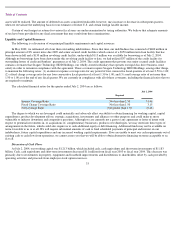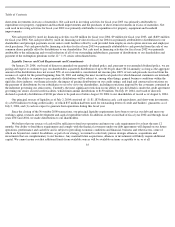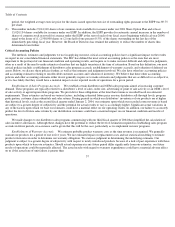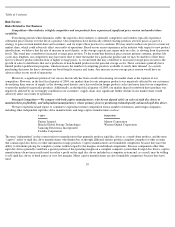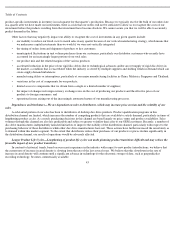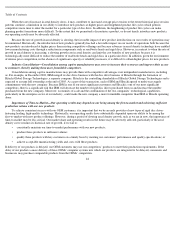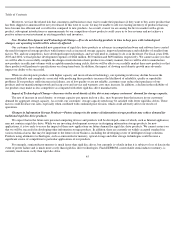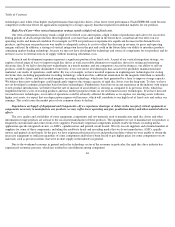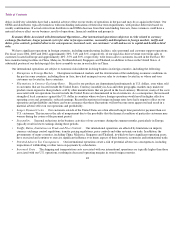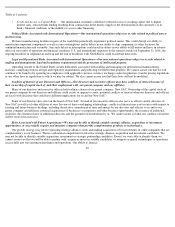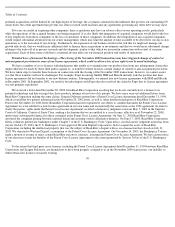Seagate 2003 Annual Report Download - page 42
Download and view the complete annual report
Please find page 42 of the 2003 Seagate annual report below. You can navigate through the pages in the report by either clicking on the pages listed below, or by using the keyword search tool below to find specific information within the annual report.
Table of Contents
We recently announced 12 new rigid disc drive products which will be introduced in the current fiscal year, many of which will address
rigid disc drive applications for which we currently have no product offerings. Some of these new products introduce new form factors, such as
our first 1-inch form factor rigid disc drive and our first 2.5-inch form factor rigid disc drive for enterprise applications. Some of these new
products also introduce higher levels of areal density than our existing products. We believe that our near-term financial results, including our
ability to achieve the results included in publicly announced forecasts will depend heavily on the successful introduction and customer
acceptance of these new products.
The success of our new product introductions is dependent on a number of factors, including market acceptance, our ability to manage the
risks associated with product transitions, the effective management of inventory levels in line with anticipated product demand, and the risk
that our new products will have quality problems or other defects in the early stages of introduction that were not anticipated in the design of
those products. Accordingly, we cannot accurately determine the ultimate effect that our new products will have on our sales or results of
operations.
In addition, the success of our new product introductions is dependent upon our ability to qualify as a primary source of supply with our
OEM customers. In order for our products to be considered by our customers for qualification, we must be among the leaders in time-to-
market
with those new products. Once a product is accepted for qualification testing, any failure or delay in the qualification process or a requirement
that we requalify can result in our losing sales to that customer until new products are introduced. The limited number of high-volume OEMs
magnifies the effect of missing a product qualification opportunity. These risks are further magnified because we expect competitive pressures
to result in declining sales and declining gross margins on our current generation products. We cannot assure you that we will be among the
leaders in time-to-market with new products or that we will be able to successfully qualify new products with our customers in the future.
Smaller Form Factor Rigid Disc Drives—If we do not continue to successfully market smaller form factor rigid disc drives, our
business may suffer.
Increases in sales of notebook computers and in areal density are resulting in a shift to smaller form factor rigid disc drives for an
expanding number of applications, including personal computers, enterprise storage applications and consumer electronic devices. Many of
these applications have typically used rigid disc drives with a 3.5-inch form factor, which we currently manufacture. Notebook computers
typically use 2.5-
inch form factor rigid disc drives. We initiated volume shipments of our Momentus notebook disc drive to a number of OEMs
in the second fiscal quarter of 2004. These shipments materially contributed to our results of operations in the second fiscal quarter. However,
our recently introduced products only address a limited portion of the existing notebook market and in our third fiscal quarter of 2004, ended
April 2, 2004, an oversupply of notebook disc drives in the supply chain led to a significant reduction in our shipments of Momentus which
adversely impacted our results of operations. We recently announced our first 1-inch form factor rigid disc drive, additional capacity models of
our Momentus notebook disc drive and a 2.5-inch form factor disc drive for enterprise storage applications. These products are scheduled for
introduction during fiscal year 2005. If we do not successfully introduce these products or if we do not suitably adapt our technology and
product offerings to successfully develop and introduce additional smaller form factor rigid disc drives, customers may decrease the amounts of
our products that they purchase which would adversely affect our results of operations.
Importance of Reducing Operating Costs—If we do not reduce our operating expenses, we will not be able to compete effectively in
our industry.
Our strategy involves, to a substantial degree, increasing revenue while at the same time reducing operating expenses. In this regard, we
have engaged in ongoing, company-wide manufacturing efficiency activities intended to increase productivity and reduce costs. These
activities have included closures and transfers of facilities, significant personnel reductions and efforts to increase automation. For example, in
our fourth fiscal quarter of 2004, we undertook significant restructuring activities to reduce the costs of our operations and we
41




